How to glue the wallpaper back to back?
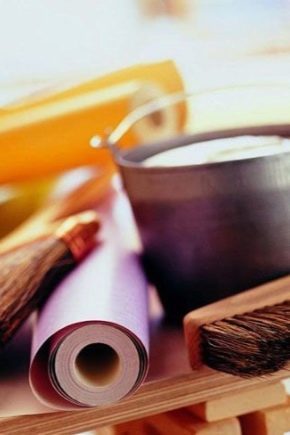
Each person at least once in his life was engaged in repairs in his apartment. Not all work can be done independently, but pasting walls with wallpaper end-to-end is quite within the power of everyone. In order to correctly complete the design, you need to take into account some of the nuances so that the surface of the walls becomes even and attractive.
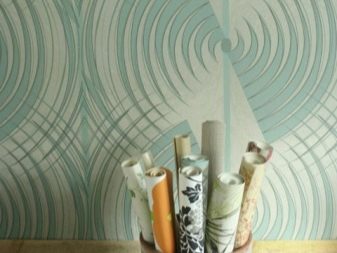

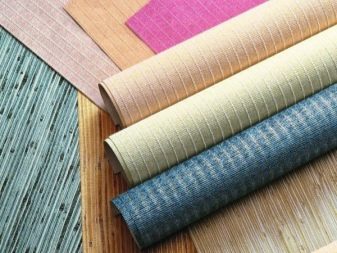
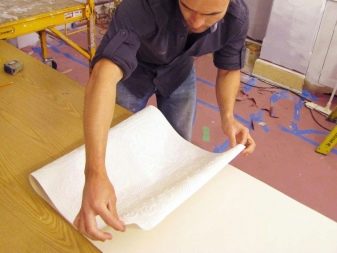
Views
In order to properly glue the wallpaper, you first need to decide on the choice of the type. And for this it is necessary to understand their classification. The division of wallpaper into different types depends on many factors, namely, on their water resistance, type of surface, density and pattern.
There are several main types of wallpaper.
- The most common and cheapest are paper wallpaper, subdivided into smooth structural types. Paper wallpapers are suitable for pasting almost any living room. They are environmentally friendly, but not durable enough.
- Vinyl wallpapers refer to waterproof types, consisting of two layers. The lower paper (fabric) base is covered with a layer of PVC, and a pattern or embossing is applied on top of it. To protect them from mold, they are treated with special compounds. The PVC layer protects the wallpaper from moisture, light and mechanical damage.
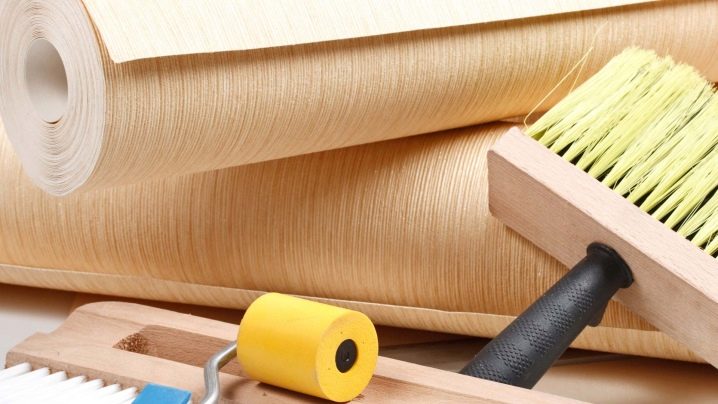
- Textile wallpaper consist of two layers: the main paper layer and the upper one, consisting of fabric fibers. As fibers, threads of cotton, flax, viscose and other fabrics are used, which are applied by gluing to the main canvas. Sometimes fabric is used as a base.
- Less common types include fiberglass wallpaper... The basis of such wallpaper is glass, which is subjected to heating, as a result of which threads are formed that undergo weaving. Fiberglass wallpapers can be either single-layer, consisting only of threads, and two-layer, where, in addition to threads, there is also paper.
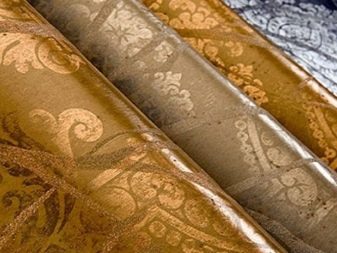
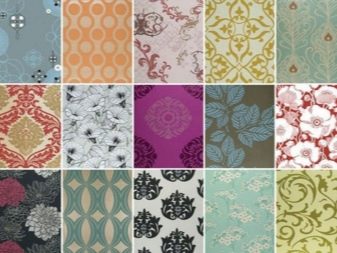
Types of docking
Most types of wallpaper have a certain pattern. The pattern applied to the wallpaper is repeated after a certain interval, which is usually called a rapport. There are several types of wallpaper docking, which are in direct proportion to the location of the pattern.

Direct docking
Very often, many buyers ask themselves what direct docking is and in what cases it is used. In order to answer these questions, you must first figure out for which drawings this method is applicable. Direct joining is used for those types where the pattern in each roll begins with one fragment and is evenly distributed over the entire area of the roll.
Direct joining on rolls is indicated by two directional arrows → ¦ ←, and the number indicates through what interval the pattern will be repeated. Direct joining of Figure 64 means that the pattern will repeat after 64 cm. This means that for a wall with a height of 250 cm, it is necessary to cut off a 256 cm long canvas, and for a height of 280 cm, you will have to cut 320 cm from the canvas. Alas, 40 cm will have to be thrown away, otherwise the drawing will not be combined.
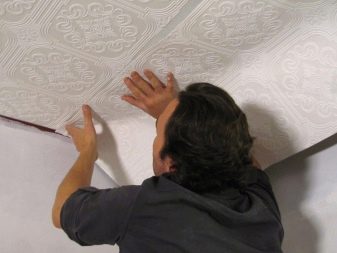

Displaced
This method is suitable for wallpaper where the pattern has straight lines or geometric patterns. On the wallpaper, manufacturers also indicate the offset with two arrows, but one arrow is shifted slightly downward.The offset method is used for wallpaper, where the pattern on each roll begins with different fragments. In order for the pattern to acquire the correct shape, you will have to shift the canvas by half the rapport. On the advice of experts, it is better to pasting using two rolls at the same time. Thanks to this method, a reduction in consumption can be achieved.
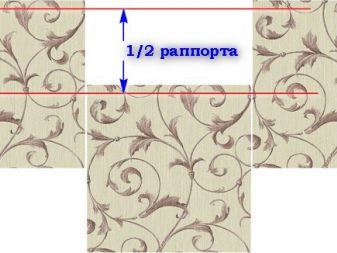
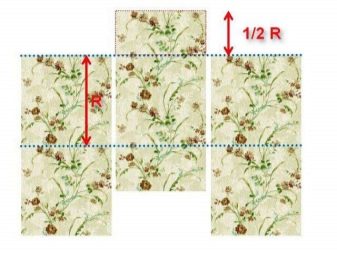
Free
This method of pasting is used for options where the pattern is applied in a chaotic manner without a clearly marked pattern. It is the most economical and simplest. The rolls are consumed almost completely, and any person can handle the pasting if desired.
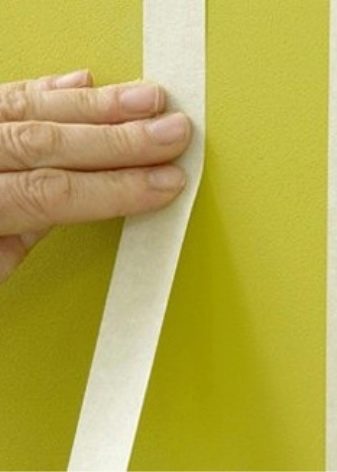
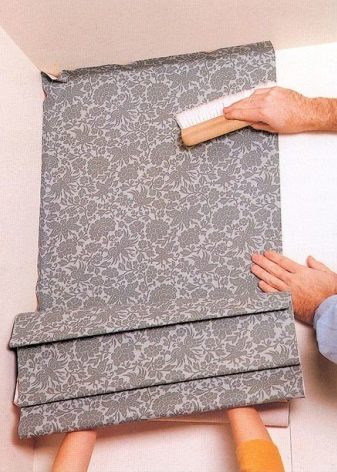
Counter
This method of joining is suitable for different patterns. In order to combine the pattern, you need to glue each subsequent canvas in the opposite direction relative to the previous one. This method is also indicated by two arrows ↑ ↓.

Mixed
The mixed method refers to a combination of two or three gluing methods. One method is chosen as the main one, and in hard-to-reach places for pasting, the most convenient method for a given area is used.
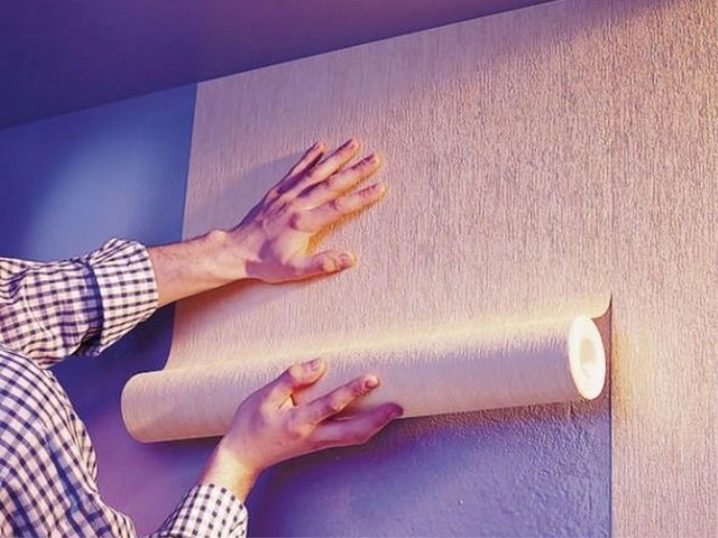
Materials and tools
When pasting any surface, you must stock up on a certain set of tools and auxiliary materials.
- First of all, you need to prepare the wallpaper yourself and a suitable glue.
- A stepladder is required for quick access to high points.
- A small table is needed to accommodate tools and materials at hand.
- In a plastic bucket, glue is bred, and a bath will be needed to squeeze out excess glue.
- To apply the glue, you can use a foam roller or brush, and for better adhesion of the seams, you will need a joint tape and a rubber roller.
- Plastic spatulas will help remove air bubbles and excess adhesive mass.
- Smooth the wallpaper with a wallpaper brush.
- With the help of a building level and a plumb line, you can evenly glue the canvas.
- A tape measure, pencil, knife and scissors come in handy for precise cutting of the wallpaper.
For information on how to properly glue the wallpaper, see the next video.
Technology
In order to properly glue any kind of back-to-back wallpaper, you need to adhere to certain rules.
First of all, it is necessary to prepare an adhesive composition, and then cut the wallpaper into canvases, adding 5 cm to the required length. The next step will be to smear the wallpaper with an adhesive composition. It is necessary to turn the cut cloth upside down and carefully apply the composition from the center to the edges, avoiding glue getting on the front side.
The canvas with the applied composition is folded in half and left for some time to be impregnated. As a rule, wallpaper manufacturers indicate the holding time of the impregnated canvas.
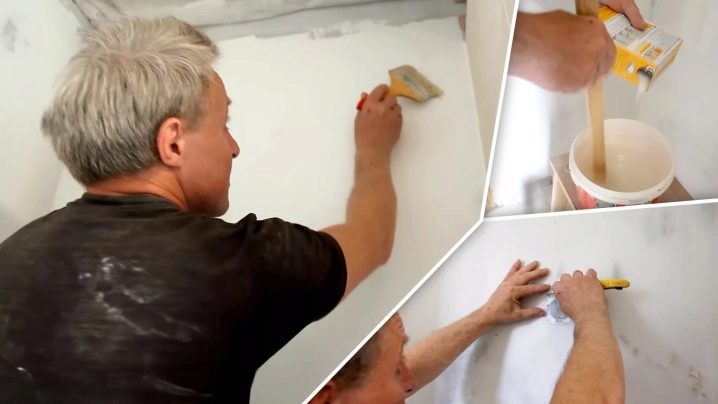
Now you can start drawing a guideline for the sticker.
Using a plumb line and a pencil, draw a line on the wall and glue the first strip, starting from the window opening and moving from the ceiling to the floor with a reference point to the previously drawn line. Smooth the pasted canvas from the center to the edges. The next canvas is glued next to the previous one, aligned to the pattern and carefully ironed over the entire surface.
In order to make the joints invisible, you need to use a rubberized roller. In order to hide the joints not only at the points of contact of two canvases, but also between the wall and the ceiling, you can use a horizontal and vertical border. Borders will help not only hide the joints, but also delineate the space.
When gluing any room, it is necessary to observe the temperature regime. The minimum temperature is +20 degrees. In addition, it is necessary to tightly close windows and doors both during the process, and even more so after its completion, in order to prevent the web from leaving the surface.
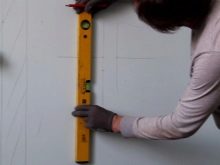
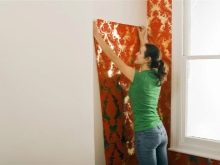
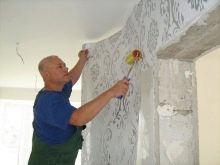
How to join in corners?
In order to properly dock the wallpaper in the corners, you need to adhere to certain rules.
- The distance from the edge of the last glued sheet to the corner is measured and the corresponding strip is cut with a margin of 5 cm. The surface of the wall and corner is processed with glue. The prepared canvas is glued from the wallpaper strip to the corner with a slight approach to another wall.
- The resulting overlap is almost always uneven. Next, you need to determine the place where the canvas is at the smallest distance from the corner. From this place you need to retreat 1 cm towards the corner and draw a vertical line. The next canvas will be glued from it in full width, with an overlap. After gluing the canvases, you must trim both canvases at the same time.
- Next, remove the cut off the remnants of the wallpaper. In order to remove the part located at the bottom, you need to move the edge of the canvas, and the upper part can be easily removed.
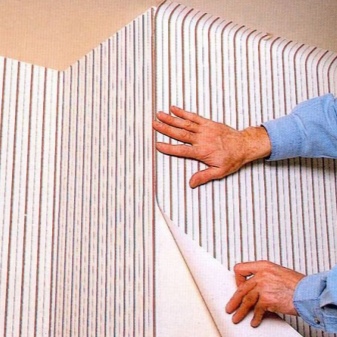
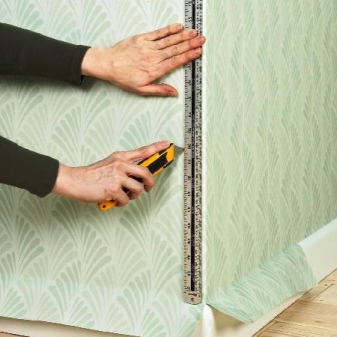
How to glue two types of wallpaper?
Sometimes owners choose two types of wallpaper to decorate the walls of residential premises. They can be of different colors or different textures.
There are several ways of pasting.
- When combining vertically, the wallpaper is glued as usual. If desired, the edges of the canvases can be designed in the form of zigzags or waves.
- The most common method is the horizontal method, when one type is glued in the upper part of the wall, and another in the lower half.
There are other ways to combine, but they are less common.
Next, we will talk in more detail about the horizontal method.
First you need to determine the line of the wallpaper joint, then draw a horizontal line. Measure the distance from the ceiling to the line and cut the canvas by adding 5 cm. Calculate the size of the second canvas in the same way and proceed to pasting. First glue the top sheet, you do not need to glue the bottom strip. Then, in the same way, glue the bottom sheet, which will have the upper part not glued. After the canvases are completely dry, remove the excess wallpaper, and glue and press the joints.
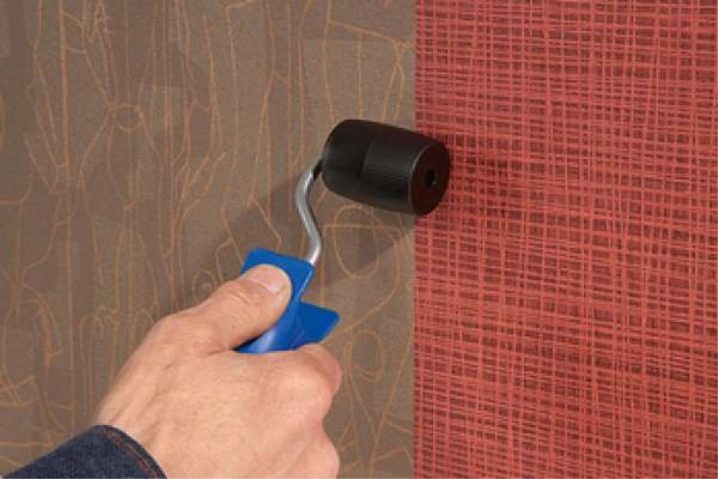
Matching photowall-paper with usual
Very often, wall murals are used to decorate the walls, which are combined with ordinary wallpaper. For correct joining, you need to select ordinary wallpaper similar in density to the photo wallpaper, and after gluing the canvases, it is better to additionally coat the joints with PVA glue. It must be remembered that the first sheet of photowall-paper must be glued strictly vertically, otherwise the picture may be skewed. In addition, for each type of wallpaper, you must use a different type of glue.
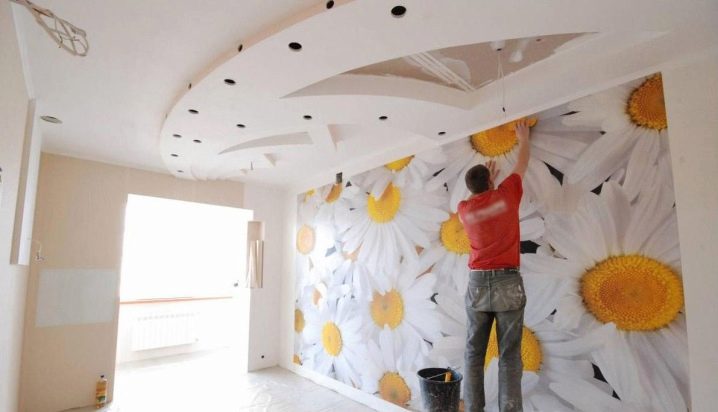
Features of gluing
Each type of wallpaper has its own characteristics for gluing.
- The easiest way is to glue paper types of wallpaper... When gluing, it must be remembered that this type of wallpaper is not strong enough, and therefore, when smoothing the strip on the wall, you need to be extremely careful not to damage the canvas, otherwise you cannot avoid tearing the base. In order to avoid the formation of gaps in the joints, it is undesirable to allow the fabric to become excessively wet, since when the fabric dries completely, the fabric shrinks, which inevitably leads to the formation of gaps.
- In order to correctly dock heavy monochromatic vinyl or non-woven wallpaper without gaps, it is necessary to apply the adhesive base not only to the canvases, but also to the wall. This method will allow you to move the heavy canvas as accurately as possible to the adjacent strip.
- For silkscreen wallpaper it is necessary to carefully prepare the surface, it must be perfectly flat. This requirement is not accidental and is associated with the texture of this type of wallpaper. They have no relief, and any unevenness after pasting will be noticeable.
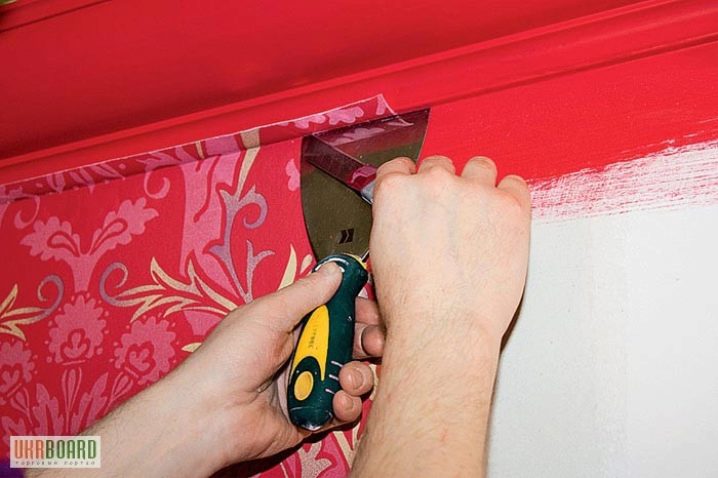
What if the seam breaks?
Sometimes, after gluing the wallpaper, the seams in the area of the joints diverge, and there may be several reasons for this. The most common reason is poor quality processing materials. When exposed to glue, the material with which the processing was carried out moves away from the wall along with the wallpaper. Sometimes the seam comes off at the joints when glued to an uneven wall.Another equally common reason that the seams have come off at the joints is the incomplete cleaning of the wall from dust and the absence of a primer on the surface.

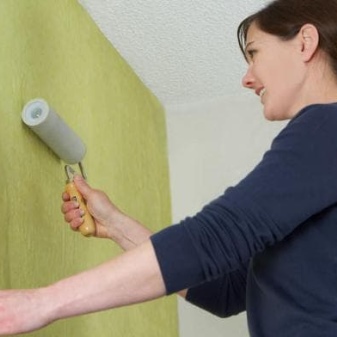
But if the reasons are not so large-scale, then you can take emergency measures and fix the situation.
- If the edges of the wallpaper simply come off, then you can glue the seams with your own hands, without resorting to the help of specialists. To do this, you just need to grease the edges with glue, press well against the wall and dry them with a hair dryer.
- If the edges do not come off, but just parted, then you can use special tools, especially if the gap is very small. For colored wallpaper, you can use a sealant, choosing a shade to match the canvas. If the color of the wallpaper is predominantly white, then you can use a putty. But it is worth remembering that the sealant and putty are not very similar to the structure of the wallpaper, and therefore, upon close examination, the seams will be noticeable.
- It is easier to seal large gaps with thin strips, which are cut from the remnants of wallpaper used in pasting the walls. This method is laborious but effective. The main thing is to do everything carefully.
- The resulting cracks can still be decorated. A border, cord or a special sticker for joints can be used as a decor.
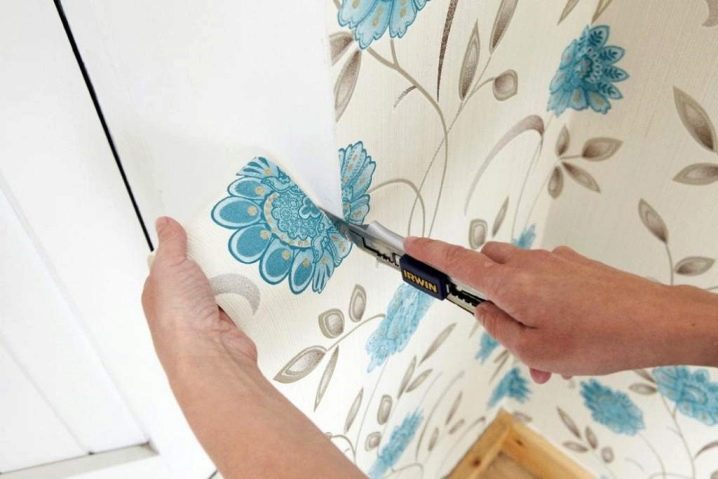
Beautiful interiors
In order to create a beautiful interior for any room, you need to choose wallpaper that matches the color and structure. With their help, you can achieve various desired effects.
If the room is small and the windows face the north side, then light-colored wallpaper will add light to it.
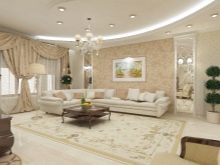

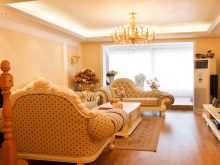
Dark tones can be used to highlight a specific area of the room. Most often they are combined with lighter shades.
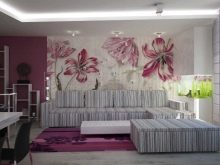
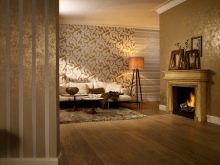
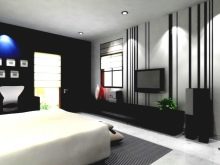
Sometimes, to create accents, bright wallpapers are framed around the perimeter with a special bar. It looks very nice and impressive.
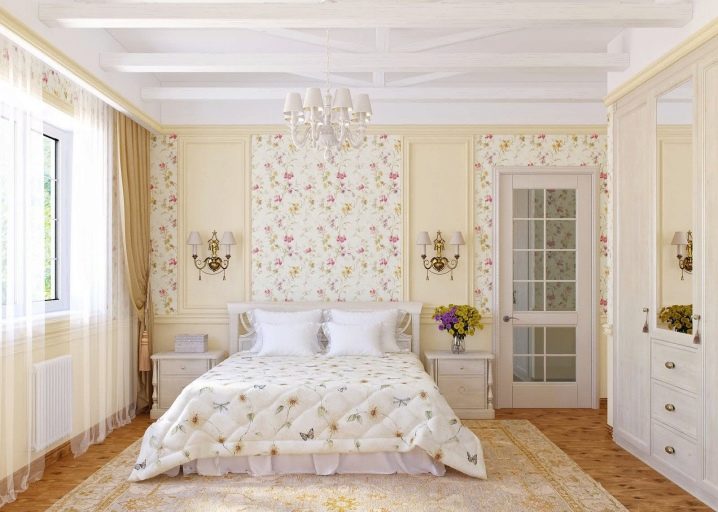
To decorate the walls, along with the usual ones, photo wallpapers are used. With their help, you can not only create a comfortable environment in any room, but also expand the space without global repair work.

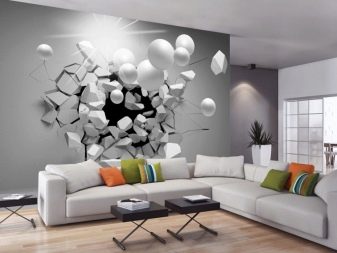
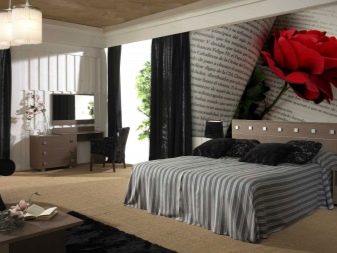
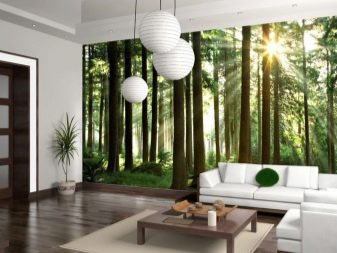













The comment was sent successfully.